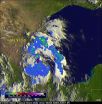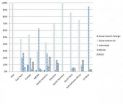Near-extinct African amphibians 'invisible' under climate change
2014-09-05
(Press-News.org) An international team of researchers has found that the majority of threatened species are 'invisible' when using modern methods to predict species distributions under climate change.
Using African amphibians as a case study, the researchers found that more than 90 per cent of the species listed as threatened on The IUCN Red List of Threatened Species are omitted by the most popular tools for species distribution modelling.
The study, led by researchers from the Universities of York and Copenhagen and the United Nations Environment Programme World Conservation Monitoring Centre (UNEP-WCMC) in Cambridge, is published in the journal Diversity and Distributions.
Dr Philip Platts, lead author and Research Fellow with York's Environment Department, said: "Modern methods to predict species distributions under climate change typically leave out rare and threatened species - the ones that currently underpin global spending on conservation. This is because those species, almost by definition, have too few data for their spatial distributions to be modelled using standard tools. We looked at whether missing them out makes a difference for conservation priority setting, either now or under future climates."
The researchers found that under the current climate, statistical restrictions on species distribution modelling means that important sites for narrow-ranging and threatened species are systematically down-played. They say this issue spans many species-groups and is only partially mitigated by modelling at finer spatial scales.
However, when they looked at climate change in the future, they found that persistence among both narrow and wide-ranging species is likely to be highest in sites already identified for conservation investment. Many such sites are projected to experience lower rates of climatic change, echoing historical processes underlying their importance. The wealth of species accumulated, in part, because they were able to persist during large-scale climatic shifts.
The researchers conclude that the focus on existing priorities ought to be maintained, noting that due to forest clearance for agriculture and demand for wood-based fuels, many species could now be incapable of tracking even relatively small changes in climate.
Dr Raquel Garcia, from the Centre for Macroecology, Evolution and Climate (CMEC) at the University of Copenhagen, who co-led the study, said: "Effective biodiversity conservation, both now and in the future, relies on our ability to assess patterns of threat across all species, but particularly those close to extinction. There are ways around the problem, such as combining simple measures of exposure to climate change with knowledge of species' ability to disperse or adapt – methods less reliant on sophisticated modelling tools, which are impractical for many of the rarest species."
The researchers examined data on 733 African amphibians in Sub-Saharan Africa. They found that 400 have too few records to be used in species distribution modelling at continental scales, including 92 per cent of those listed as Vulnerable, Endangered or Critically Endangered on The IUCN Red List. Amphibians were chosen for the study because of the high rates of threat they are predicted to face from climate change, habitat loss and disease, especially in Africa.
Professor Neil Burgess, Head of Science at UNEP-WCMC and Principal Investigator on the study, said: "These results show that unless we use appropriate analysis for the impacts of climate change on species such as amphibians, we risk leaving many rare species under-represented in conservation plans, with the potential to misguide conservation efforts on the ground."
INFORMATION:
The study also involved the National Museum of Natural Sciences, Madrid; the University of Évora, Portugal; the Biodiversity and Climate Research Centre, Frankfurt; the University of the Witwatersrand, Johannesburg; the IUCN Species Survival Commission, Gland, Switzerland; Imperial College London; and the World Wildlife Fund–US.
ELSE PRESS RELEASES FROM THIS DATE:
Caffeine therapy for apnea of prematurity does not have long-term harmful effects on sleep
2014-09-05
Caffeine therapy for apnea of prematurity has no long-term harmful effects on sleep or control of breathing, according to a new study of 201 preterm children assessed at ages 5-12, the first study in humans to examine the long-term effects of neonatal caffeine treatment on sleep regulation and ventilatory control.
"Animal studies have suggested that administration of neonatal caffeine to premature infants, while improving survival and other outcomes, may have long-term detrimental effects on sleep and control of breathing during sleep," said lead author Carole L. Marcus, ...
Research finds no association between wearing a bra and breast cancer
2014-09-05
PHILADELPHIA — A population-based case-control study found no association between bra wearing and increased breast cancer risk among postmenopausal women, according to research published in Cancer Epidemiology, Biomarkers & Prevention, a journal of the American Association for Cancer Research.
"There have been some concerns that one of the reasons why breast cancer may be more common in developed countries compared with developing countries is differences in bra-wearing patterns," said Lu Chen, MPH, a researcher in the Public Health Sciences Division at Fred Hutchinson ...
Magnetic nanocubes self-assemble into helical superstructures
2014-09-05
Materials made from nanoparticles hold promise for myriad applications, from improved solar energy production to perfect touch screens. The challenge in creating these wonder-materials is organizing the nanoparticles into orderly arrangements.
Nanoparticles of magnetite, the most abundant magnetic material on earth, are found in living organisms from bacteria to birds. Nanocrystals of magnetite self-assemble into fine compass needles in the organism that help it to navigate.
Collaborating with nanochemists led by Rafal Klajn at the Weizmann Institute of Science in Israel, ...
A lifetime of outdoor activity may contribute to common eye disease; sunglasses may help
2014-09-04
BOSTON (Sept. 4, 2014) — Residential geography, time spent in the sun, and whether or not sunglasses are worn may help explain why some people develop exfoliation syndrome (XFS), an eye condition that is a leading cause of secondary open-angle glaucoma and can lead to an increased risk of cataract and cataract surgery complications, according to a study published on Sept. 4 in JAMA, Ophthalmology.
Despite improvements in understanding the cause of this common yet life-altering condition, more work needs to be done. "The discovery that common genetic variants in the lysyl ...
NASA sees Dolly's remnants bringing showers to the Rio Grande Valley
2014-09-04
Tropical Storm Dolly fizzled out quickly on September 3 after making landfall in eastern Mexico, and NASA's Aqua satellite saw some of the remnants moving into southern Texas. NASA's TRMM satellite analyzed the rainfall occurring in the storm as it was approaching landfall.
NASA's Aqua satellite captured the remnants of Tropical Depression Dolly over northeastern Mexico on Sept. 3 at 19:40 UTC (3:40 p.m. EDT). The image, captured by the Moderate Resolution Imaging Spectroradiometer or MODIS instrument showed the center of Dolly over northeastern Mexico with a band of thunderstorms ...
Hurricane Norbert pinwheels in NASA satellite imagery
2014-09-04
The Eastern Pacific's Hurricane Norbert resembled a pinwheel in an image from NASA's Terra satellite as bands of thunderstorms spiraled into the center. NASA's Global Precipitation Measurement or GPM mission has helped forecasters see that Norbert has lost some of its organization early on September 4.
The MODIS instrument or Moderate Resolution Imaging Spectroradiometer aboard NASA's Terra satellite captured a visible picture of Tropical Storm Norbert on Sept. 4 at 2:15 p.m. EDT when it resembled a pinwheel. The western bands of Norbert were moving over Socorro Island, ...
Climate-smart agriculture requires three-pronged global research agenda
2014-09-04
Faced with climate change and diminishing opportunities to expand productive agricultural acreage, the world needs to invest in a global research agenda addressing farm and food systems, landscape and regional issues and institutional and policy matters if it is to meet the growing worldwide demand for food, fiber and fuel, suggests an international team of researchers.
In a paper appearing online in the journal Agriculture and Food Security, the authors summarize the findings of the second international Climate Smart Agriculture conference held in March 2013 at UC Davis.
"Climate-smart ...
News media losing role as gatekeepers to new 'social mediators' on Twitter, study finds
2014-09-04
The U.S. government is doing a better job of communicating on Twitter with people in sensitive areas like the Middle East and North Africa without the participation of media organizations, according to a study co-authored by a University of Georgia researcher.
The study looked at the U.S. State Department's use of social media and identified key actors who drive its messages to audiences around the world. In particular, it examined the role played by news media and the government in bridging the State Department communication with people domestically and internationally. ...
Scientists identify rare stem cells that hold potential for infertility treatments
2014-09-04
DALLAS – Sept. 4, 2014 – Rare stem cells in testis that produce a biomarker protein called PAX7 help give rise to new sperm cells — and may hold a key to restoring fertility, research by scientists at UT Southwestern Medical Center suggests.
Researchers studying infertility in mouse models found that, unlike similar types of cells that develop into sperm, the stem cells that express PAX7 can survive treatment with toxic drugs and radiation. If the findings hold true in people, they eventually could lead to new strategies to restore or protect fertility in men undergoing ...
Sugar substitutes not so super sweet after all
2014-09-04
The taste of common sugar substitutes is often described as being much more intense than sugar, but participants in a recent study indicated that these non-nutritive sugar substitutes are no sweeter than the real thing, according to Penn State food scientists.
In the study, participants compared the taste of non-nutritive sweeteners that are often used as low- or no-calorie sugar substitutes with those of nutritive sweeteners, such as sugar, maple syrup and agave nectar. The participants indicated they could perceive the non-nutritive sweeteners -- such as aspartame, ...




